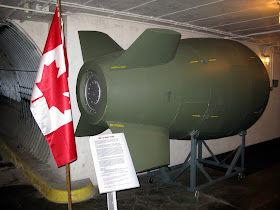This is another in a series of examples of how hard it is for model kit manufacturers to produce one with no errors of shape or detail.
The Mk 4 atomic bomb was the improved production version of the Mk 3 Fat Man that was dropped on Nagasaki. According to Chuck Hansen's book, U.S. Nuclear Weapons: The Secret History, the first one was delivered to the the national stockpile on 19 March 1949. A total of 550 were built between March 1949 and May 1951. All were retired by May 1953, replaced in part by the very similar but lighter Mk 6.
Because of the security imposed on these weapons, documentation is scarce. The 12 Squared Mk 4 kit (see Here) was based on the following drawing, which turns out to be for a 1/2 size ballistic test specimen. What looks like a gun-type mechanism (the Mk 4 actually had a spherical implosion device, accounting for its very low aspect ratio) was actually a pipe on which was mounted two 700-lb lead weights. The afterbody was a straight taper with four simple fins mounted on the back.
Bill Maloney (web page) photographed a full size Mk 4 model with this fin configuration that is in the Diefenbunker Cold War Museum about 20 miles west of Ottawa, Canada. It was built by Russ Gray in 2003 for a documentary film. Note that the afterbody is more bulbous than the drawing above.
I don't know whether the original Mk 4 had fins like the one above. The more familiar configuration has wedge-like fins.
I don't know if there are any other Mk 4 shapes on display. However, there are a few Mk 6 shapes in museums, including the National Museum of the US Air Force at Dayton, Ohio and the Museum of Aviation at Warner Robins AFB, Georgia. The Mk 6 appears to be externally identical to the Mk 4 except for circumferential stiffeners around the mid-body resulting from a change to a lightweight casing that reduced the bomb's weight by 2,000 lbs.
I wasn't happy with the first drawing that I had made of the Mk 4 for an illustration of the AJ Savage in my book Strike from the Sea, so I revisited the available material to see if I could improve it. Once again, I proved to myself that working solely from pictures leads to error. Fortunately, Bruce Radebaugh responded to my request for someone to measure the Mk 6 at Warner Robins, so I'm fairly confident that the size of the fins on my Mk 4 drawing is now about right and the body shape is close:
Bruce also took several pictures.
Although the fin looks flat on one side in the picture above, it's an optical illusion caused by the downward slant of the back half of the top of the fin. It is symmetrical.
The Mk 6 shape in the Warner Robins museum appears to be a mockup. Compare, for example, its boat tail:With the one on the Mk 6 in the Air Force museum:
I can't say which is correct; the one in the Air Force museum is likely a training aid with details not representative of the real thing.
However, the Smithsonian Air and Space Museum reportedly was given a Mk 3 that was later determined to have not been fully disarmed, so anything's possible...











Tommy,
ReplyDeleteFor the "for what it's worth" department, I would say that the USAF Museum version of the Mk IV is the more correct one and that the Warner-Robins model is the mockup more likely used for training and familiarization. The details on the back of the USAF Museum model are more consistent with an operational weapon, or at least one used for training in servicing, handling and arming such a weapon. Note the drawing that shows the internal plumbing, something you would have to access to arm/disarm or maintain the warhead.
Both of them could have been training items, but for different purposes. On the one hand, you have what are known as training shapes, which allow load crews to get accustomed to the size and weight of weapon when loading and unloading it. People tend to forget that not all weapons are dropped on target, especially nukes, so you have to go through both the loading AND the UNloading steps as part of a weapons crew.
For load training, all you need is a close approximation of size and shape. It is usually a cheaper version built to withstand a lot of abuse, banging into other objects, being dropped, etc.
The other type of training aid is the one used to acquaint bomb builders and maintainers in how to work on the actual weapon in the shop. You want them as detailed as possible, to reflect just what will be encountered in the construction and dismantling of a real weapon.
Hope this helps.
Ron
Do you happen to have any close-up photos of the yellow stencilling and the red plug on the top center aft of the USAF museum version? If so, it might be very revealing info. By the way, the yellow stripe on the circumference of the bomb body indicates live ordnance. Blue indicates practice. Somebody probably had to get an act of Congress passed to mark a nuclear weapon as having any live ordnance, even if it might only indicate live high-explosives meant to trigger the nuclear chain reaction. I run into the same issue whenever I have ordnance shapes to put on aircraft. You can't get authorization to use the colors that would be used with live ordnance, or people freak!
ReplyDeleteRon